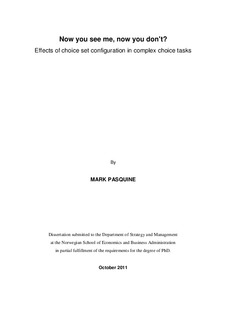Now you see me, now you don't? : effects of choice set configuration in complex choice tasks
Abstract
This dissertation considers stimulus-based influences on consumer decision-making. Context effects, referred to as set configuration effects in this dissertation, have repeatedly been shown to influence choices consumers make. For example, the choice probability of an alternative increases when a similar, but inferior alternative is added to a set originally containing two alternatives. Studies examining set configuration effects have generally been conducted using simple choice tasks; that is choice sets with few attributes and alternatives. Some authors have argued that increasing the number of alternatives and attributes, a more complex task, should reduce the probability of set configuration effects. Very few studies have utilized complex tasks to empirically test this assumption. Hence, the extent to which choice set configurations influence choice in complex tasks (i.e. more alternatives and attributes) has not been sufficiently examined. This thesis considers choice set configuration effects among consumers presented with complex choice tasks.
Five experiments were created to test the influence of set configurations on choice in more complex choice tasks than typically researched. Across these experiments, two set configurations were examined; uniqueness and asymmetric dominance. Uniqueness denotes a set configuration in which a single alternative is unique on an important attribute among heterogeneous competitor alternatives. Asymmetric dominance is a set configuration in which an alternative that is similar, but inferior, to another alternative is added to the set. Findings from several experiments indicate that these set configurations, uniqueness and asymmetric dominance, can increase choice of a target alternative in complex tasks.
A second key finding from this study is that asymmetric dominance can influence choice directly, as just discussed, and at a secondary level, or step. That is, an asymmetric dominance relationship among non-considered alternatives can influence choice among considered alternatives. To my knowledge, this type of secondary level set configuration effect has not been observed in the literature. Secondary level set configuration effects were moderated by task complexity (simple vs. complex) and product involvement (high vs. low): secondary level effects were observed in higher involving, complex tasks. I argue that salience of an asymmetric dominance relationship leads to a comparison of considered alternatives to a non-considered, yet good alternative. This comparison can help consumers discriminate among the considered alternatives. Findings lend support to this suggested mechanism for secondary level set configuration effects.
